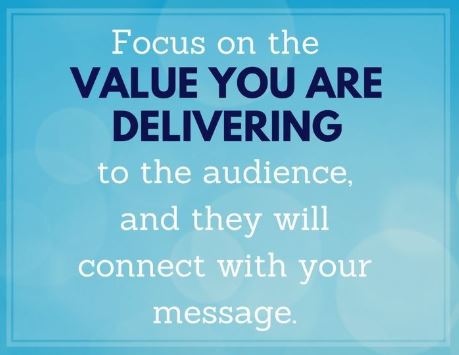I used to be so hyper-vigilant of my anxiety while speaking, I would rush through, “hiding” and ignoring my audience. Once I learned the technique, to focus on my message, my whole mindset changed about public speaking.
Nervousness vs Fear
Nervousness is the energy we feel right before a speech. It’s the energy of excitement, of anticipation, of being the center of attention. Fear is what we feel when we perceive this energy in a negative way, especially when we try to suppress it instead of accept it. Nervousness shows that you care about the topic! Without nerves you would come across flat and would not be able to connect with the audience.
When asked to give a speech, we tend to feel nervous and start thinking of ways to ease our anxiety. We may set goals like trying to please the boss, trying to come across as confident or think about how we can rush through it as quickly as possible just to get it over with.
Public Speaking is About Sharing
It’s about sharing your message and connecting with the audience on an emotional level in order to make them feel what we feel, understand the importance of something, share our passion or just to make them laugh. Think about why we still deliver speeches and presentations in today’s world when we can send the same information to millions of people with a click of a button. It’s because, unlike emails, public speaking allows us to communicate on an emotional level and resonate with the audience much better than any other source could.
Speaking Techniques vs The Real You
Unfortunately, when many people think about how to enhance their public speaking skills, they immediately think about learning techniques such as voice projection, hand gestures and body movement. They end up being preoccupied with these techniques instead of truly delivering their message and passion.
If our hand gestures are not stemming from within, we may come across as artificial. If we move on the stage without feeling the need to connect with people, we may come across as mechanical.
If we apply confident gestures such as smiling and having open body language without feeling it internally, we may come across over confident. Aim at bringing the real you to the front of the room and you’ll notice that you naturally apply all these techniques.
It’s Not About You!
To put it succinctly: no, it’s not about you. It’s about contributing value to the audience, mainly by teaching them something they didn’t know before.
Instead of focusing on yourself, focus on the audience and especially on the message you want to get across. This is what the audience cares about – not you.
Maybe this is why humor, openness and a willingness to show vulnerability go a long way. When you don’t take yourself too seriously and instead show everybody (yourself and the audience) that it’s not about you, but rather about the content of what you’re saying, it reduces the pressure and eliminates anxiety.
Action Step
Apply the technique of focusing on your message – not on your anxiety. Start small, such as a meeting at work, or an introduction at an event. Remind yourself that everyone isn’t scrutinizing you, trying to detect your anxiety. They want to hear what you have to say, what they could learn from you!



